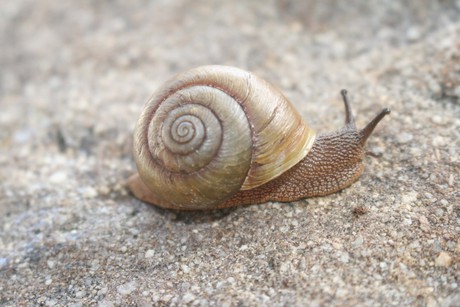New species of snail discovered

A new species of snail has been discovered by a Bush Blitz expedition that took place on Bush Heritage Australia’s Carnarvon Station Reserve in the highlands of southern Queensland.
Bush Blitz is a nature-discovery partnership between the Australian Government, BHP Billiton Sustainable Communities and Earthwatch Australia, focused on discovering new species of plants and animals. Recorded species are provided to Bush Heritage to help them manage the ecosystems and habitats of Carnarvon Station Reserve.
The new snail was discovered by BHP Billiton employee Ellen Couchman, who was assisting snail expert Dr John Stanisic on an expedition in October 2014. Dr Stanisic has now confirmed that the species, Pallidex simonhudsoni, is new to science.
“Like many of Australia’s 1500 species of land snail, it has a very localised distribution,” Dr Stanisic said. “This makes them extremely vulnerable to the effects of habitat destruction through broad acre land clearance and fire.”
The snails are commonly found in patches of remnant rainforest known as ‘vine thickets’, which have been subject to extensive and often indiscriminate clearing in the past. “This begs the question as to how many species have been lost that we haven’t even known about,” said Dr Stanton.
The Bush Blitz expedition to Carnarvon Station Reserve involved scientists from the Queensland Museum, Australian National Herbarium, University of NSW, Qld Department of Primary Industries and South Australia Museum. Couchman described the experience as “mind blowing”.
“The thing that gets me is that you can turn over a rock or go for a walk in a paddock and find a new species,” she said. “It really drives home how little is known about Australian plants and animals, and the importance of the Bush Blitz program.”
In addition to the new species discovered by Couchman, Dr Stanisic found another five species of snail that he believes are new to science. Other scientists on the expedition recorded 36 reptiles and frogs, 35 types of bee, over 40 spider species and at least one new species of stygofauna (animals that live in groundwater).
According to Earthwatch CEO Professor David McInnes, Couchman’s discovery “demonstrates how little we know about our own biodiversity and signifies the importance and uniqueness of Bush Blitz”. Australia is home to more unique plants and animals than any other country on Earth - 75% of which are unknown to science and 99% of which are invertebrates.
“By documenting and describing Australia’s unique flora and fauna, we are providing the essential information to help manage and protect some of Australia’s most fragile and precious ecosystems,” Professor McInnes said.
How light helps plants survive in harsh environments
Researchers from National Taiwan University have uncovered how light stabilises a key...
SKA-Low's first image of the universe released
The image is an indication of the scientific revelations that will be possible with the...
Which blood test is best at monitoring ALS?
A new study compares three types of blood biomarkers: neurofilament light chain proteins, glial...




